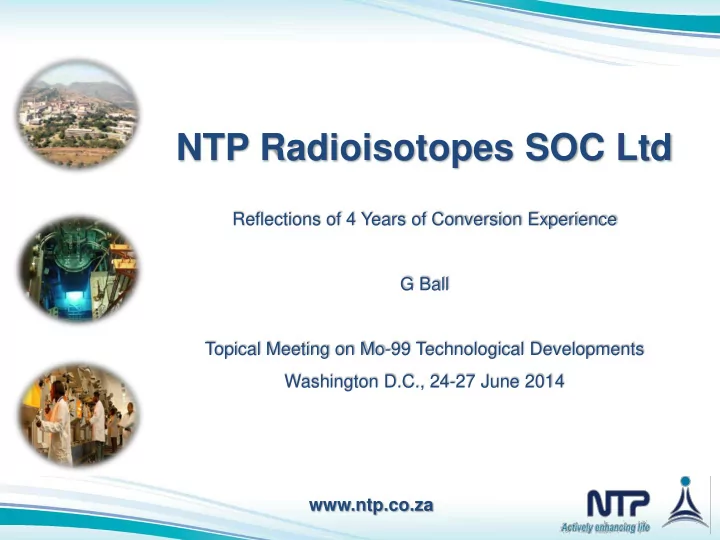

NTP Radioisotopes SOC Ltd Reflections of 4 Years of Conversion Experience G Ball Topical Meeting on Mo-99 Technological Developments Washington D.C., 24-27 June 2014 www.ntp.co.za
Outline – Brief Background – Current Status – Experienced gained – Future sustainability
Background - Time Line Year Event 2007 Theoretical feasibility studies 2008 Cold and depleted uranium experiments Oct 2009 NNR approval received for test stage and first hot runs commence Mar/Apr 2010 Process validation runs performed Jun 2010 Submission to NNR for routine LEU 99 Mo production Submission of DMF to Medical Regulators commenced Jul 2010 Customer tests and validation runs commenced Sep 2010 NNR approval received for routine operation with LEU Sep 2010 US FDA approves LEU 99 Mo for a customer in the US Dec 2010 First large scale commercial FDA approved batch of LEU 99 Mo produced and shipped to US for patient use Jun 2011 Routine commercial supply of LEU 99 Mo commenced to some customers Sep 2011 Commencement of investment in plant modifications (due to conversion) Mar 2012 Commenced with project to regain lost production capacity
Background – Target Details Parameter LEU HEU Meat Dispersion Alloy Enrichment (%) 19.75 45.0 Uranium Density (g.cm -3 ) 2.75 1.42 Dimensions (mm) 200/50/1.66 200/50/1.66 Cladding Alloy Pure aluminium U-235 Loading Maintain (or minimise decrease)
Current Status – 99 Mo % LEU Distribution relative to all LEU runs 50 45 40 35 2009 30 2010 25 2011 2012 20 2013 15 10 5 0 2009 2010 2011 2012 2013
Current Status – 131 I % LEU 131I Distribution 70 60 50 2009 40 2010 2011 30 2012 2013 20 10 0 2009 2010 2011 2012 2013
Current Status – Projects Dissolution Cell Reason: Required due to significant increase in uranium volumes Status: Commissioned Future: Upgrade existing dissolution hot cells
Current Status – Projects Uranium Residue Storage Facility Reason: Required due to significant increase in uranium volumes Status: Cold commissioning completed Future: Hot commissioning to be completed later in 2014
Experience Gained Technical Issues • Target Specifications • Process Parameters • Scalability • Combined HEU and LEU based 99 Mo production • Increased waste volumes 99 Mo Production with LEU is far more difficult than with HEU
Experience Gained Financial & Other Issues • Lower production capacity per target • Increased cost of production • Unrealistically low 99 Mo price expectations by industry • Failure of implementation of full-cost recovery initiatives • Customer appetite & Regulatory complexities Threatening the future of the nuclear medicine industry
Future Sustainability – Supply Chain Economics Re-imbursments Medical Funds Patients % Revenue 100 Hospitals 66 Radiopharmacies 25 Tc-Generators Aging infrastructure Environmental 3 Safety Political Mo-99 LEU Conversion Regulatory 1 Reactors
Future Sustainability – Industry Quotes • Publication of the High Level Group on Medical Radioisotopes (HLG) said: “This means that recent Mo-99 supply shortages were a symptom of the longer-term problem related to insufficient capital investment for a reliable supply. ” • NucNet News, No. 304 of 20 December 2012: NEA Warns of “Unsustainable Economics” of Radioisotope Supply Chain • Publication of OECD-NEA (2014): “… any delays in production from new entrants, which are not unlikely given the innovative nature of the production technologies involved, could cause supply difficulties. ”
Future Sustainability – New Producers Since the start of the 99 Mo Topical Meetings, the following has happened: • Numerous alternative methods of producing 99 Mo have been proposed and some initiated • Molybdenum activation in BWR’s; terminated in January 2012 • Aqueous homogenous reactor; Mallinckrodt withdraws from project due to unfavorable financial outlook • Completion dates of many new entrants continue to slip
Future Sustainability – Credible option Collaborative partnership gives industry a low risk, credible option for the future
Future Sustainability – Concluding Comments The future of the nuclear medicine industry depends heavily on: • Full-cost recovery through the entire supply chain • Realistic 99m Tc pricing • Aspirant entrants realisation of the actual level of effort for development, industrialisation, validation and regulatory processes • Realistic time frames from new market entrants
Future Sustainability – Concluding Comments Economic and technological challenges pose a serious threat to the future use of 99m Tc in nuclear medicine!
Recommend
More recommend